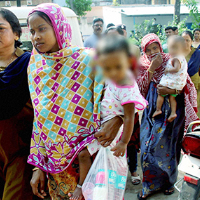NIA Says Burdwan Bombs Were Aimed at Bangladesh
 The two women arrested for the Burdwan blast entering court with their children
The two women arrested for the Burdwan blast entering court with their children
The National Investigation Agency (NIA) has confirmed the view held by most analysts that the accused persons arrested in the Burdwan blast case and their associates had been preparing IEDs for possible terror attacks in Bangladesh.
In a statement, the NIA said it had completed the initial phase of its probe into the October 2 bomb blast that took place in a house in Khagragarh village in Burdwan district of West Bengal. Two people – Shakil Ahmed and Suvon Mandal, alias Subhan – both allegedly residents of Bangladesh, were killed while allegedly manufacturing IEDs. A third person, Abdul Hakim alias Hassan, was injured and arrested along with three others, including two women.
"Investigation so far has revealed that the accused persons and their associates were the members of Jamaat-ul-Mujahideen, Bangladesh (JMB), a terrorist organisation proscribed in Bangladesh and they were preparing IEDs which were being transported to Bangladesh," the agency said in its statement.
NIA Director-General Sharad Kumar visited Burdwan on Friday and inspected the scene of the incident and also took stock of the agency’s field investigation. In the last few days, the NIA team has seized a large number of books and documents, 12 trunks and a car from a madrasa in Burdwan district, where the blast accused were suspected to have been radicalised in jihadi ideology.
The visit of the NIA chief came two weeks after the agency took over investigations into the blast. He visited the house where the blast took place as well as another house at nearby Mathpara where 40 improvised hand grenades were found.
According to Hindustan Times, interrogation reports of the two women arrested from Burdwan reveal a larger cross-border design to destabilise Bangladesh and short-circuit its bilateral relationship with India.
For several months, senior Jamaat-ul-Mujahideen operatives allegedly slipped into India to visit seven madrasas across three border districts to build a robust network in West Bengal, before the Burdwan blast exposed the growing terror network.
The West Bengal state government has come under fire from the opposition for allegedly going soft on fundamentalists in order to appease the Muslim community. From announcing separate engineering exams for minorities and a Rs. 500-crore ($83.3 million) plan for the upkeep of mosques and providing an honorarium to clerics, Chief Minister Mamata Banerjee has assiduously courted Muslim votes.
After all, the Muslim population makes up 26 percent of West Bengal’s population, almost double the national average. Latest Census data shows a 5-7 percent population increase in the last decade in the districts of West Bengal and Assam that border Bangladesh.
Migrants from Bangladesh have traditionally crossed the border for livelihood. But recent arrivals reportedly consist mostly of radical elements chased away by the Sheikh Hasina government. These migrants seem to be finding protection in West Bengal under the ruling Trinamool Congress party that allegedly uses them to supply it with votes and muscle power.
That perhaps explains why the West Bengal police did not initially charge the blast accused with terrorism and other serious offences, allegedly in order to keep the NIA at bay. It was only after public pressure that the state administration reluctantly agreed to allow the NIA to investigate the case.
There are allegations that the police, instead of handing over to the NIA the materials recovered, had destroyed all the evidence it found at the site of the bomb blast.
To Learn More:
Burdwan bombs meant for Bangladesh, says NIA (PTI)
Larger terror design behind Burdwan blast? (by Saikat Datta, Hindustan Times)
Burdwan blast: Is Bengal police shielding accused? (by Soumen Datta, Hindustan Times)
Mamata's votebank politics takes Bengal to edge (by Abhijit Majumder, Hindustan Times)
Burdwan Blast: West Bengal under Mamata a safe haven for Jihadis, says BJP (PTI)
- Top Stories
- Controversies
- Where is the Money Going?
- India and the World
- Appointments and Resignations
- Unusual News
- Latest News
- India College Chain’s Expansion into U.S. Draws Opposition from Massachusetts Officials over Quality of Education
- Milk Shortages in India Tied to Release of New Movies Featuring Nation’s Favorite Stars
- Confusion Swirls around Kashmir Newspaper Ban in Wake of Violent Street Protests
- Polio-Free for 5 Years, India Launches Vaccine Drive after Polio Strain Discovery
- New Aviation Policy Could Increase Service, Lower Ticket Prices






Comments